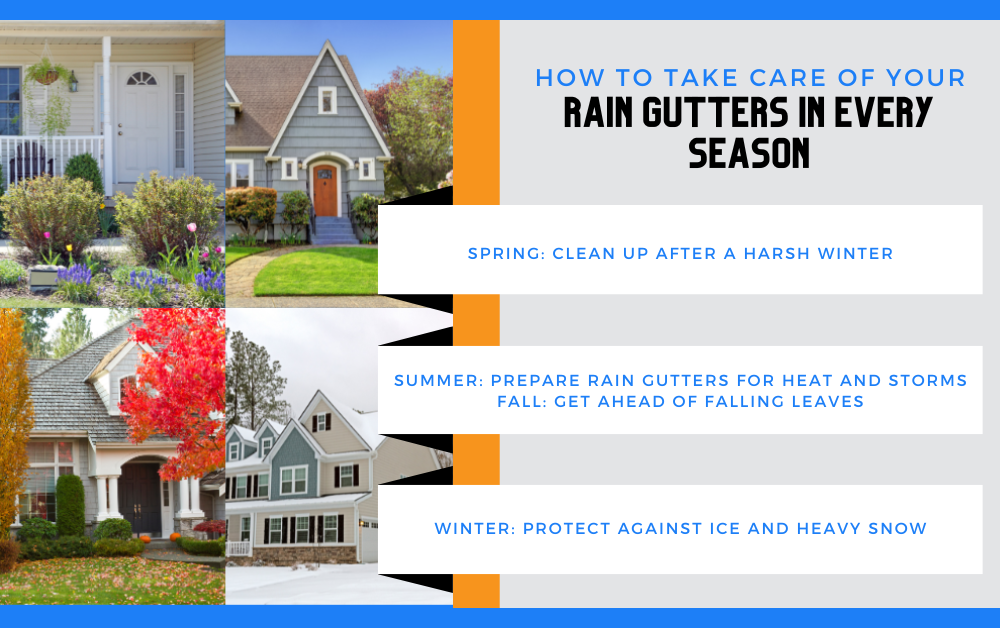Rain gutters play a critical role in protecting your home by channeling water safely away from your roof, siding, and foundation. Without proper care, they can clog, overflow, or even pull away from your house, leading to costly damage. Each season brings new challenges, from spring debris to winter ice. Here’s how homeowners can keep their rain gutters working properly all year long.
Spring: Clean Up After a Harsh Winter
Inspect for Winter Damage
Cold temperatures, ice, and heavy snow can take a serious toll on your rain gutters. Look closely for cracks, split seams, or joints that have pulled apart. Even small gaps can allow water to leak behind your gutters and damage fascia boards. Sagging sections are another warning sign that ice or snow weight stressed the system. Address these issues early so spring rains don’t turn them into bigger, more expensive problems.
Remove Twigs, Leaves, and Shingle Grit
Winter winds often leave your gutters full of leftover leaves, broken twigs, and granules from asphalt shingles. This debris can quickly block water flow, leading to overflow during spring showers. Cleaning out your rain gutters thoroughly helps keep water moving efficiently through the system and prevents damage to your siding or foundation.
Test with a Hose
After clearing debris, run water through your gutters with a garden hose. Watch for leaks underneath or places where water spills over rather than draining to downspouts. Testing water flow now ensures your rain gutters are fully ready to handle heavier spring and summer rains.
Check Downspouts and Splash Blocks
Clogged or disconnected downspouts defeat the purpose of clean gutters. Make sure each downspout is free of blockages and securely attached. Verify that water exits at least 3-4 feet from your foundation using splash blocks or extensions to protect your basement and landscaping.
Summer: Prepare Rain Gutters for Heat and Storms
Tighten Loose Fasteners
Throughout summer, heat causes your gutters to expand and contract. This natural movement can loosen screws, hangers, and brackets over time. Inspect along the length of your rain gutters, tightening any areas that appear wobbly or pulling away from the house. Secure fasteners help your system handle sudden summer downpours without sagging or separating.
Trim Trees and Overhanging Branches
Summer is the perfect time to prune back any trees or branches hanging over your roof. Leaves, twigs, and seeds can drop into your rain gutters during thunderstorms, quickly causing clogs. Trimming also reduces the risk of branches breaking and damaging your gutters during high winds.
Install or Inspect Gutter Guards
If you don’t already have them, summer is an excellent time to add gutter guards. These screens or covers help keep debris out, cutting down on maintenance needs in the busy fall season. If you already have guards, inspect them to ensure they’re securely in place and free from smaller blockages that might restrict water flow.
Watch for Warping
Prolonged exposure to hot sun can cause certain gutter materials to warp, sag, or fade. Walk around your home and look for sections that appear uneven or discolored. Catching small issues now keeps them from worsening under the weight of future storms or debris.
Fall: Get Ahead of Falling Leaves
Schedule Professional Cleaning
Fall is the season most likely to overwhelm your rain gutters. As trees shed their leaves, your gutters can quickly fill and clog. Scheduling a professional cleaning ensures your entire system, including downspouts, is completely clear before late fall rains and early winter snow arrive.
Inspect Slope Toward Downspouts
Rain gutters should slope slightly—typically a quarter inch per ten feet—toward downspouts to direct water efficiently. Over time, hangers can loosen or wood can warp, changing this slope. Check that water flows smoothly toward the downspouts without pooling in low spots.
Look for Nests and Pests
Birds and small rodents sometimes build nests in gutters, especially when they’re packed with fallen leaves. Clear out any nests or signs of critters to prevent blockages that lead to overflow and water damage along your siding and foundation.
Check Downspout Extensions
Make sure downspout extensions are properly attached and positioned to channel water well away from your home. This helps keep your foundation dry and prevents soil erosion near your walls, which could lead to costly structural issues later.
Winter: Protect Against Ice and Heavy Snow
Clean Gutters Before Snowfall
Before the first big snowfall, make sure your rain gutters and downspouts are clear. Clogged gutters trap melting snow, which can refreeze overnight, forming ice dams. These dams force water back under shingles, increasing the risk of leaks into your attic or walls.
Watch for Ice Buildup and Icicles
Long icicles hanging from your gutters might look pretty but often indicate trouble. They’re usually a sign of poor drainage and ice buildup inside your rain gutters. This extra weight can pull gutters away from the house, damaging both the gutter system and your fascia boards.
Use Roof Rakes Carefully
After heavy snowfalls, a roof rake lets you safely remove some of the snow load, reducing stress on your gutters. Always work from the ground to avoid accidents, and take care not to damage shingles or gutter edges.
Inspect for Gutter Separation
Repeated freezing and thawing, combined with heavy snow or ice, can slowly pry rain gutters loose from your home. Walk around your house every few weeks to look for any sections pulling away. Catching problems early can save you from more extensive repairs come spring.
Conclusion
Taking care of your rain gutters throughout the year is one of the simplest ways to protect your home from costly water damage. From clearing out winter debris in spring to preventing ice buildup in winter, regular seasonal maintenance keeps your gutters flowing freely and your home safe. Trust L.R. Wilson Seamless Gutters for expert cleaning, gutter guard installations, and repairs that keep your rain gutters working at their best through every season.

